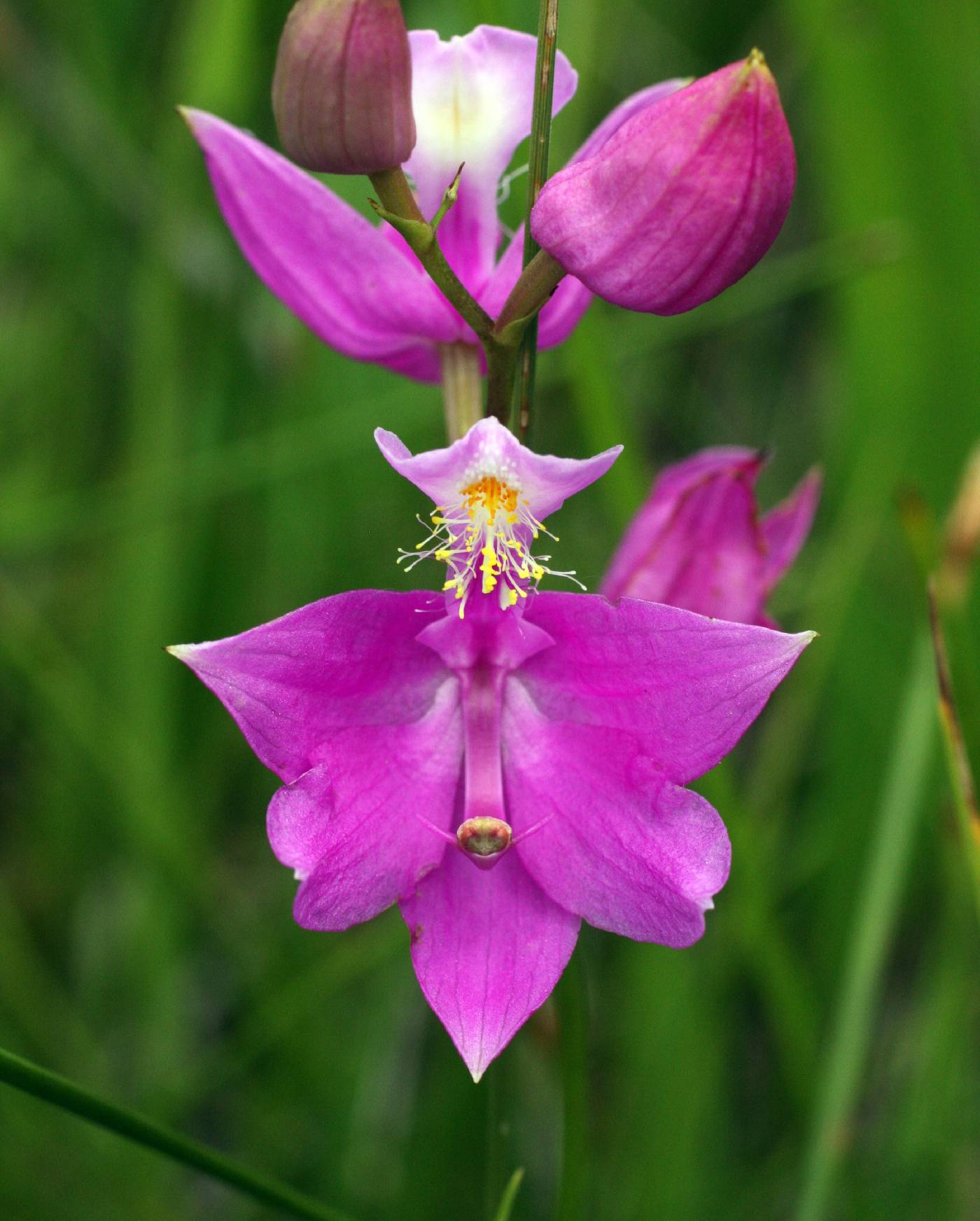
|
Family: Orchidaceae |
Herbs, perennial, terrestrial, scapose, sympodial. Roots from globose, ellipsoid, oblong, or forked corms, 0.5-2 mm wide. Stems: glabrous; cauline bracts 2-3, sheathing. Leaves 1(-3), sessile; blade linear, lanceolate, or elliptic-lanceolate, conduplicate, frequently prominently veined. Inflorescences terminal, 1(-3) racemose spikes, 1-25-flowered (ovaries not pedicellate despite appearance), scapose; flowers opening nearly simultaneously to sequentially; floral bracts subulate, lanceolate, or ovate, typically small. Flowers not resupinate, magenta, deep rose pink, pale pink, or white, sometimes fragrant, sessile; dorsal sepal lanceolate; lateral sepals ovate to nearly lanceolate, falcate, apex apiculate to acuminate; petals linear, ovate, elliptic, lanceolate, or oblanceolate, sometimes pandurate, clawed; lip basally hinged, obscurely 3-lobed, middle lobe distally dilated into triangular or broadly rounded lamina, large, lateral lobes 2, small; disc with 2-3 longitudinal lamellae grading distally into brush of hairlike protuberances; protuberances white, yellow, or orange to magenta, elongate, filiform to clavellate; column arcuate, broadly dilated at distal end; anther terminal, green to crimson; pollinia 4 in 2 pairs, soft and mealy; viscidium absent; pollen grains in tetrads. Fruits capsules, erect, cylindric, ellipsoid, or obconic; column persistent in mature capsule. Based on morphology and allozymes, D. W. Trapnell (1995) determined that all taxa she sampled, which did not include Calopogon oklahomensis and C. tuberosus var. latifolius, were properly circumscribed, although results were not strongly conclusive about relationships among the species. Based on DNA data, D. H. Goldman (2000) determined that C. multiflorus and C. pallidus are most closely related, although the relationships of the other taxa were not as certain. DNA evidence did support the circumscription of all taxa except C. tuberosus var. latifolius, which was in agreement with the work of P. M. Catling and Z. Lucas (1987). Plastid DNA sequences suggested that Calopogon is most closely related to the eastern North American genus Arethusa, and the Asian genera Anthogonium, Arundina, and Eleorchis (D. H. Goldman 2000; D. H. Goldman et al. 2001). Calopogon appears to exhibit deceit pollination (L. van der Pijl and C. H. Dodson 1966; L. B. Thien and B. G. Marcks 1972; D. H. Firmage and F. R. Cole 1988; J. T. Boland and P. J. Scott 1991). This occurs when pollinating bees land on the lip and try to gather pollen off the large hairlike protuberances that resemble anthers. The weight of the pollinator causes the lip to fall, dropping the pollinator backwards onto the column; pollinia adhere to the back of the bee and subsequently are carried to another flower. Soft pollinia in Calopogon had been noted to be an evolutionary reversal to facilitate pollination by hairy bees (W. P. Stoutamire 1971).
Fls nectarless, not resupinate, the lip uppermost; sep and lateral pet nearly alike, spreading, the lateral sep inequilateral, wider than the lateral pet; lip spreading, long-stalked, dilated at the summit and densely bearded along the inner side with long clavate hairs; column elongate, curved, 2-winged distally; anther terminal, with 4 pollinia; perennial from a corm, the slender stem with 1 or 2 basal sheathing scales, a single long grass-like lf near the base, and a short raceme of 2-several fls. 4, e. N. Amer. Gleason, Henry A. & Cronquist, Arthur J. 1991. Manual of vascular plants of northeastern United States and adjacent Canada. lxxv + 910 pp. ©The New York Botanical Garden. All rights reserved. Used by permission. |
This project was made possible in part by the Institute of Museum and Library Services [MG-70-19-0057-19].
Powered by Symbiota



